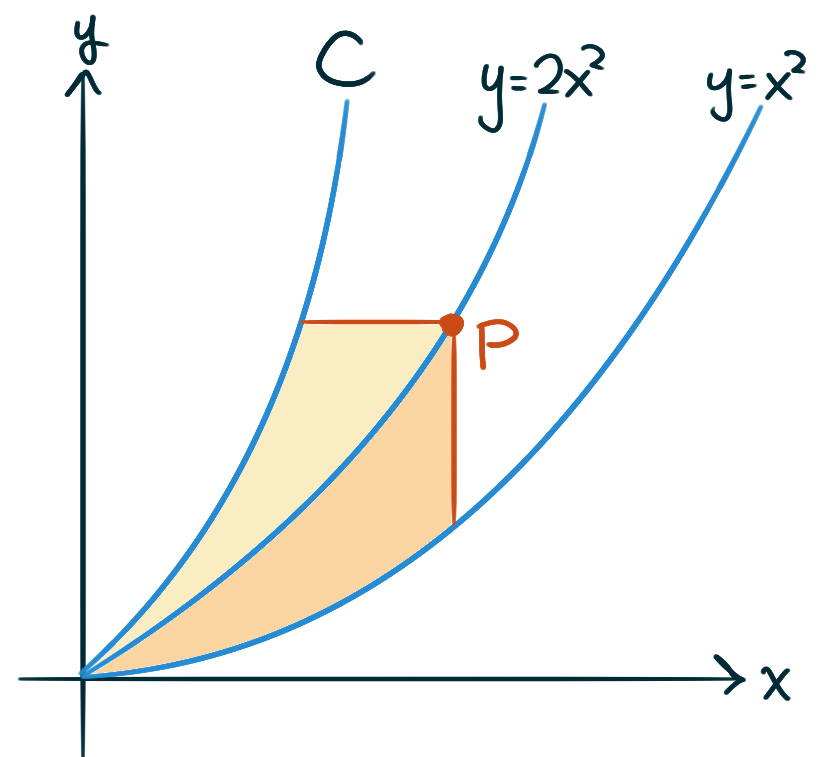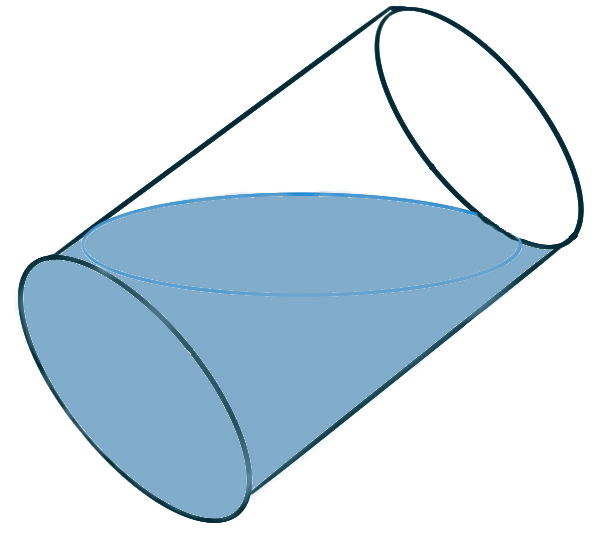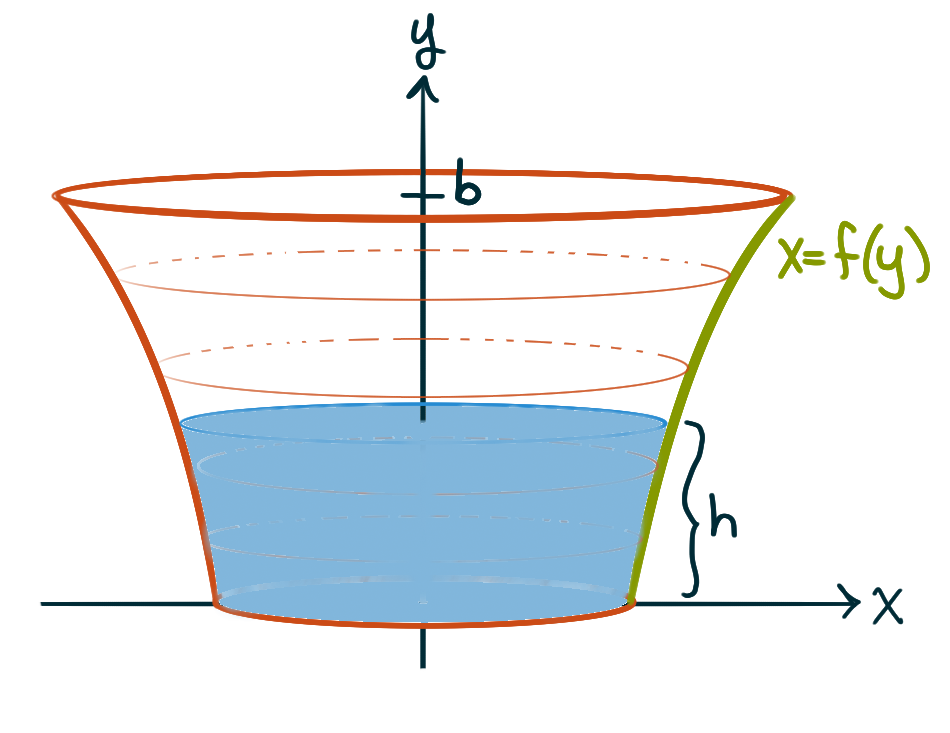- Calculate the area of the region in the \(xy\)-plane enclosed between the curves given by the equations \(y=x^2\) and \(y=x+6.\)
- Calculate the area of the region enclosed between the curves \(y=x^2\) and \(y=2-x^2.\)
- What’s the area of a single “hump” under the graph of sine?
- Consider the region enclosed by the curves \(y=x^2\) and \(y=x^3.\) Write two different integrals, one with respect to \(x\) and the other with respect to \(y,\) that represent the area of this region, then calculate the values of each of these integrals to verify they have the same value.
- What’s the area of the triangle in the \(xy\)-plane with vertices located at coordinates \((1,1),\) \((7,2),\) and \((5,8)?\) Bonus: look up and use Pick’s Theorem to verify your calculation.
- Calculate the area of the region in the \(xy\)-plane enclosed between the curves given by the equations \(y=\sqrt{x}\) and \(y=6-x\) and \(y=0.\) Protip: integrate with respect to \(y\) so you can set it up as a single integral.
- Calculate the area of the region in the \(xy\)-plane enclosed between the curves given by the equations \(y=\sec^2(x)\) and \(y=8\cos(x).\)
- The curves \(y=\sin(x)\) and \(y=\cos(x)\) enclose a region consisting of infinitely many repeating copies of a single shape. What’s the area of this shape?
- James Stewart There is a line through the origin that divides the region bounded by the parabola \(y=x-x^2\) and the \(x\)-axis into two regions with equal area. What is the slope of that line?
- James Stewart If the tangent at a point \(P\) on the curve \(y = x^3\) intersects the curve again at \(Q\), let \(A\) be the area of the region bounded by the curve and the line segment \(PQ\). Let \(B\) be the area of the region defined in the same way starting with \(Q\) instead of \(P\). What is the relationship between \(A\) and \(B\)?
-
James Stewart
The figure shows three curves, \(y=x^2,\) \(y=2x^2,\) and \(C,\)
such that for every point \(P\) on the middle curve \(y = 2x^2\),
the shaded areas are equal. Find an equation for \(C\).

-
Consider the region enclosed by the curves \(y=x^2\) and \(y=x^3\).
- Consider the solid generated by revolving this region about the \(y\)-axis. First make a sketch this solid. Like, really, make it look good. Then write two different integrals, one with respect to \(x\) and the other with respect to \(y\), that represent the volume of this solid. Calculate the values of these integrals to verify their values are the same.
- Do the same thing, but this time considering the solid generated by revolving the region about the \(x\)-axis instead. Before doing any calculations, anticipate whether this volume will be larger or smaller than the previous volume.
- Now suppose the region is the base of a solid whose cross-sections parallel to the \(y\)-axis are all equilateral triangles, a side of which lies in the region. First make a sketch this solid, Then calculate the volume of this solid. Protip: sketch the base region “flat”, foreshortened on your paper, then sketch the solid “above” it.
- Consider a single instance of one of the regions bound between the curves \({y = \sin(x)}\) and \({y = \cos(x).}\) What is the volume of the solid formed by revolving this region about the line \(y = 2?\)
-
For each of the following solids described, make a quality sketch of the solid and calculate its volume.
- A solid whose base is the region bound by the curves \(y = 1-x^2\) and the \(x\)-axis, and whose cross section perpendicular to the \(y\)-axis are isosceles triangles with height equal to the length of their base.
- Spivak A solid that has circular base with diameter \(\overline{AB}\) of length \(\ell\) such that each plane that is perpendicular to \(\overline{AB}\) intersects the solid in a square.
-
Calculate formulas for the volumes of these ubiquitous geometric solids.
- A right circular-based cone with height \(h\) and base radius \(r.\) It being a “right” cone means that the cone’s “point” lies directly over the center of its base.
- A sphere of radius \(r.\) (Hint: the curve \({y=\sqrt{r^2-x^2}}\) describes …)
- A regular tetrahedron (d4) — a solid with four sides that are each an equilateral triangle of edge length \(\ell.\)
- A regular octahedron (d8) — a solid with eight sides that are each an equilateral triangle of edge length \(\ell.\)
- Dawkins An object is being moved along an axis. At \(x\) meters from its initial position, a force of \(F(x) = x^2-\cos(3x) +2\) acts on the object. What is the work required to move the object from \(x=3\) to \(x=7\),
- Dawkins A cable with mass \(\frac 1 2\text{ kg/m}\) is lifting a load of \(150\text{ kg}\) that is initially at the bottom of a \(50\) meter shaft. How much work is required to lift the load a quarter of the way up the shaft?
- A \(2\,\mathrm{kg}\) model rocket is loaded up with \(3,\mathrm{kg}\) of rocket fuel. When launched the rocket rises off the earth at a constant rate of \(111\,\mathrm{m/s}\), expending fuel at a rate of \(0.25\,\mathrm{kg/s}\). Write down an integral that represents the amount of work done by the rocket between launch and the moment the rocket runs out of fuel.
- Suppose you have a perfectly spherical stone about the size of a cantaloupe. Using a massive drill, you bore a hole completely through the stone, through its center, resulting in a large radially symmetric stone ``bead''. You measure that the hole though the bead, from the edge on one side to the edge on the other, is exactly six inches long. What is the volume of the bead?
- For a length \(r,\) imagine a right circular-cone with base radius \(r\) and height \(r\) nested inside a half-sphere of radius \(r\) nested inside a right circular-cylinder with base radius \(r\) and height \(r.\) Show the ratio of their volumes is \(1:2:3.\)
- Cavalieri’s Principle What is the volume of a circular-based cone with height \(h\) and base radius \(r\) whose “point” does not lie over the center of its base?
- Consider two intersecting circular cylinders, each of of radius \(r,\) whose central axes intersect at a right angle, Calculate the volume of the solid that is the intersection of these cylinders.
- You have a bowl full of water, the shape of which is exactly half of a sphere of radius \(r\). You tilt the bowl thirty degrees, spilling out some of the water. What is the volume of the remaining water?
-
James Stewart A cylindrical glass of radius \(r\) and height \(L\) is filled with water and then tilted until the water remaining in the glass exactly covers its base.

- Determine a way to “slice” the water into parallel rectangular cross-sections and then set up a definite integral for the volume of the water in the glass.
- Determine a way to “slice” the water into parallel cross-sections that are trapezoids and then set up a definite integral for the volume of the water.
- Calculate the volume of the water in the glass by evaluating one of the integrals you set up. Then figure out volume of the water in the glass simply by considering the geometry of the situation.
- Suppose the glass is tilted until the water exactly covers half the base. In what direction can you “slice” the water into triangular cross-sections? Rectangular cross-sections? Cross-sections that are segments of circles? Find the volume of water in the glass.
-
James Stewart A clepsydra, or water clock, is a glass container with a small hole in the bottom through which water can flow. The “clock” is calibrated for measuring time by placing markings on the container corresponding to water levels at equally spaced times. Let \(x = f(y)\) be continuous on the interval \([0, b]\) and assume that the container is formed by rotating the graph of \(f\) about the \(y\)-axis. Let \(V\) denote the volume of water and \(h\) the height of the water level at time \(f\).

- Determine \(V\) as a function of \(h\).
- Show that \( \dot{V} = \pi \big(f(h)\big)^2 \dot{h} \,.\)
- Suppose that \(A\) is the area of the hole in the bottom of the container. It follows from Torricelli’s Law that the rate of change of the volume of the water is given by \( \dot{V} = kA \sqrt{h} \) where \(k\) is a negative constant. Determine a formula for the function \(f\) such that \(\dot{h}\) is a constant \(C\). What is the advantage in having \(\dot{h} = C\)?